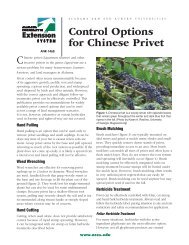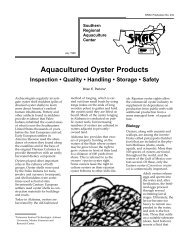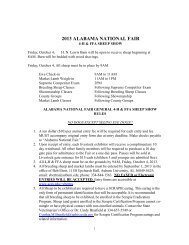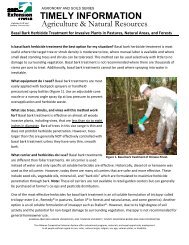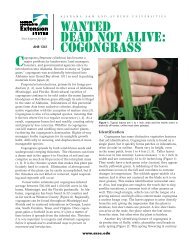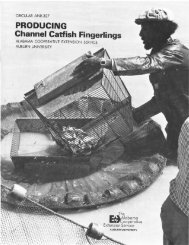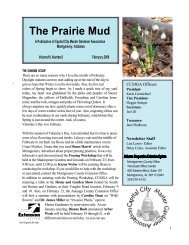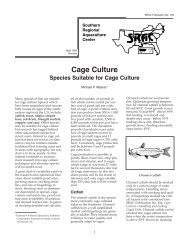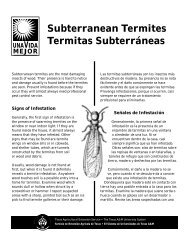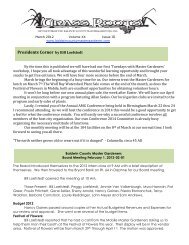Species Profile: Pinfish, Lagodon rhomboides - SRAC Fact Sheets
Species Profile: Pinfish, Lagodon rhomboides - SRAC Fact Sheets
Species Profile: Pinfish, Lagodon rhomboides - SRAC Fact Sheets
You also want an ePaper? Increase the reach of your titles
YUMPU automatically turns print PDFs into web optimized ePapers that Google loves.
As fish larvae increase in size, so should feeding frequency<br />
and prey size. Larger Artemia or adult copepods<br />
should be fed to pinfish larvae as they grow. Unenriched<br />
instar I Artemia should be introduced to pinfish larvae at<br />
13 DPH and a feeding density up to 1.3 Artemia per mL<br />
should be maintained until 38 DPH. Larvae can be completely<br />
weaned onto a microparticulate diet by 39 DPH,<br />
and as fish size increases, a finfish starter #1 crumble<br />
(50 to 55 percent protein and 15 percent lipid) should be<br />
gradually introduced. Weaning to an artificial diet should<br />
begin about 30 DPH and after the feeding of Artemia, but<br />
the dietary shift must be gradual to ensure a successful<br />
transition. Uneaten feed should be removed to prevent<br />
water quality problems.<br />
Juveniles<br />
Early juveniles have fully formed fins and range in<br />
size from 0.47 to 0.55 inches (12.0 to 13.9 mm) SL. <strong>Pinfish</strong><br />
grow rapidly and can reach a marketable size of 1.97 to 4.9<br />
inches (50 to 125 mm) midway through their first year of<br />
life. Juveniles 0.43 to 0.71 inches (11 to 18 mm) long have<br />
been found to survive in a wide range of water temperatures<br />
and salinities. This inherent tolerance may give<br />
producers more flexibility in culturing pinfish. Culture<br />
success will depend on growth, survival, system design,<br />
environmental conditions (temperature, salinity, dissolved<br />
oxygen), and diet (feed composition and ration).<br />
Growout<br />
Captive juvenile pinfish are easily feed trained and<br />
readily consume formulated commercial diets (50 to 55<br />
percent protein and 15 percent lipid). Juveniles survive<br />
well when cultured in recirculating aquaculture systems<br />
and will grow to marketable bait size at high densities<br />
and reduced salinity. Densities of 0.05, 0.2, 0.4 and 0.6<br />
fish per L have been evaluated at a salinity of 27 g/L with<br />
temperatures ranging from 71.6 to 84.2 °F (22 to 29 °C).<br />
<strong>Pinfish</strong> grew 0.35 to 0.39 g/day with a mean survival of 94<br />
to 99 percent over 82 days. Mean food conversion ratios<br />
(FCR) ranged from 1.7 to 1.9. Growth in different densities<br />
is shown in Figure 6. This graph will help producers<br />
estimate the time required from culture to market size for<br />
two size classes at the initiation of growout.<br />
Two salinities (9 and 27 g/L) have been evaluated for<br />
pinfish. Mean percent weight gain ranged from 234 to 284<br />
percent with no significant differences between salinities.<br />
Food conversion ratios ranged from 2.5 to 3.1. Survival<br />
was not different between salinities and exceeded 98 percent<br />
in all tanks over 65 days.<br />
Further studies in recirculating aquaculture systems<br />
and land-based ponds are needed to develop the most<br />
4<br />
Figure 6. <strong>Pinfish</strong> growth at various stocking densities.<br />
appropriate culture techniques and protocols. Further<br />
research is warranted to identify low-salinity culture<br />
methods and systems.<br />
Markets<br />
<strong>Pinfish</strong> are a popular live bait used by recreational<br />
and commercial fishermen. They are sold in wholesale<br />
and retail markets along the Atlantic Coast and Gulf of<br />
Mexico. Market-size pinfish are harvested from the wild.<br />
The availability of pinfish varies by season and from one<br />
location to another, and the size of fish available from<br />
the wild is not always what is in high demand. The size<br />
pinfish anglers want depends on the species they are trying<br />
to catch. <strong>Pinfish</strong> ranging from 1.5 to 6.0 inches (3.75<br />
to 15 cm) are frequently used by both inshore and offshore<br />
anglers. Wholesale prices of pinfish are $0.30 to $0.66 per<br />
fish, with retail prices ranging from $0.45 to $1.50 per fish.<br />
Wholesale and retail prices fluctuate throughout the year<br />
and are dependent on previously mentioned variables.<br />
Conclusion<br />
<strong>Pinfish</strong> show great potential as a new aquaculture<br />
species for the southeastern U. S. <strong>Pinfish</strong> are hardy, grow<br />
rapidly, tolerate a wide range of environmental conditions,<br />
have a high market demand, and thrive in captivity.<br />
Well-established wholesale and retail markets and distribution<br />
networks for pinfish as live bait already exist. These<br />
characteristics strongly justify further research with pinfish<br />
aquaculture to improve the hatchery stage of culture<br />
(possibly through brood and larval nutrition), to evaluate<br />
growout systems (including low-salinity tank and pond<br />
culture), and to study the economics of pinfish production.



